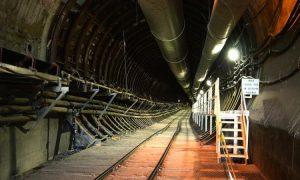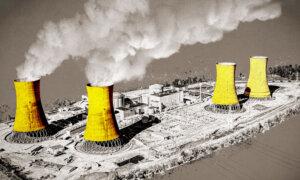Subcommittee on Energy, Climate, and Grid Security rehashed the costly problem this week, but did not define any real solutions.
The United States still has no plan for permanently storing more than 94,000 tons of highly radioactive spent nuclear waste produced by nuclear power plants, despite a 1998 deadline that required the federal Department of Energy (DOE) to have a facility available to accept the waste. House members of the Subcommittee on Energy, Climate, and Grid Security rehashed the costly problem in a hearing this week, finding bipartisan agreement that the problem must be solved, but they did not define any real solutions.
The nation’s first nuclear power plant, in Shippingport, Pennsylvania, went online in 1957, with many more having gone into operation since. Some have completed their life cycles and no longer have operating reactors. But with no permanent storage, spent fuel from these reactors is being stored at 75 sites in 34 states, and continues to accumulate by about 2,000 tons a year. The expense of temporary storage and security for spent fuel was not factored into the planning stages when these nuclear plants were built. The government promised to have a plan.
In 1998, nuclear utilities began filing lawsuits to recover additional storage costs. Taxpayers have spent $10.6 billion on temporary storage and the DOE estimates its potential future liabilities for delays in taking spent radioactive fuel could reach $41 billion in additional expenditures, according to a committee memo on the matter.
The figure of $2 million per day was mentioned numerous times as the cost to taxpayers until a permanent solution is available.
Storage of the fuel is not a technical problem, but a sociopolitical one. The United States has spent millions to build a permanent storage facility at Yucca Mountain in Nevada, but it was politically blocked, testified Lake H. Barrett, former Principal Deputy Director at the Office of Civilian Radioactive Waste.
“It is simply irresponsible to continually saddle our children, grandchildren, and future generations with spent nuclear fuel sitting in thousands of canisters in dozens of temporary storage locations scattered across the country with no place to go, while the financial liabilities grow and grow,” Mr. Barrett said.
Yucca Mountain
The Nuclear Waste Policy Act of 1982 initially directed the DOE to find a storage location for commercially generated spent nuclear fuel and begin removing and transporting waste by Jan. 31, 1998. The DOE identified Yucca Mountain in Nye County by 1987 and, after navigating years of regulations, and spending over $15 billion, it was eventually built.
With the promise of 3,000 jobs, there was local support for the project, Nye County residents previously told The Epoch Times.
In 2008 the DOE sought a license to operate Yucca Mountain from the Nuclear Regulatory Commission (NRC), but the license never materialized.
Then in 2010, under pressure from Nevada officials, President Barack Obama abandoned the Yucca Mountain project and made a motion to withdraw the Yucca Mountain license application from the NRC, the memo said. His administration dismantled the DOE office responsible for implementing the Nuclear Waste Policy Act, terminated all activities to support the repository program, and established the Blue Ribbon Commission on America’s Nuclear Future to conduct a review of policies for managing nuclear waste, including alternatives for storage.
By 2013, the Blue Ribbon Commission offered a solution: gather more opinions from stakeholders through a “consent-based siting process.” It took until 2017 to define how the consent-based siting process would work. The DOE is now in a two-year process of “collecting perspectives” on how to handle highly radioactive spent nuclear fuel through listening sessions with the public, and panelists representing nonprofits, professional societies, and national, regional, and state groups, according to listening session held in February.
“We watch with envy as geologic disposal programs in Finland, Sweden, Switzerland, France, and Canada make great progress, but currently we are going nowhere,” Mr. Barrett said.
More Nuclear Power
As part of its environmental agenda, the United States is considering developing advanced clean nuclear energy sources, because nuclear produces very little carbon dioxide. By reprocessing and recycling, some spent nuclear fuel can be reduced in both volume and toxicity, Mr. Barrett said, but this will not eliminate all high-level nuclear waste.
“Regardless of future nuclear development or not, we need a responsible geologic disposal program in this country now for the wastes we have already generated over the past 80 years, and for the material we will generate in the future,” Mr. Barrett said.
Before any new, advanced reactors go into operation, there should be a plan for waste disposal, he said.
The DOE has attempted to move forward with interim storage of spent nuclear fuel. In this scenario, waste would be moved from nuclear power plants to temporary storage, and then moved again, to permanent storage once that is worked out. Private companies have attempted to get interim storage five times, but each project has been stopped by host states. The hearing panel seemed to agree that host states are unlikely to agree to temporary storage when there is no long-term plan, because they could end up storing the waste indefinitely.
“Congress and the executive branch should work together to address America’s nuclear-waste stalemate. This is not only an issue for the nuclear industry, but also for U.S. taxpayers,” testified John Wagner, director of the Idaho National Laboratory, the nation’s nuclear energy research and development center. Mr. Wagner leads a $1.8 billion DOE national laboratory with approximately 6,100 scientists and engineers.
“To provide for the fulfillment of our legacy spent-fuel management responsibilities, and to fully realize the potential of our existing and future nuclear energy systems, we must have a functioning nuclear-waste-management policy framework.”
Committee Chairman Rep. Jeff Duncan (R-S.C.) ended the hearing saying the would have to decide “where to go from here,” and that the solution will likely require legislative action.
Those testifying recommended developing a new independent waste management organization to expedite a solution.
Original News Source Link – Epoch Times
Running For Office? Conservative Campaign Consulting – Election Day Strategies!


